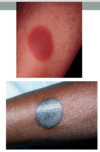Urticaria and Drug Rashes - Schwarzenberger Flashcards
Describe the pathophysiology of urticaria
An inflammatory skin reaction caused by the release of histamine/other cytokines
Are all cases of urticaria allergen associated?
No, allergic or non-allergic
Timeframe of urticaria? Why is this important?
Each individual urticaria wheal will last no longer than 24 hours; if a single wheal lasts longer, reconsider the dx
(but whole episode can last longer)
What is angioedema in the context of urticaria? how long does it last?
swelling of the deeper dermis and subQ tissue; up to 72 hours
Drugs that commonly cause acute urticaria?
B-lactam abx, NSAIDs, ASA, opiates, IV radiocontrast
What cause of acute urticaria is seen in children frequently, but not in adults?
Food allergen induced
Differentiation between acute urticaria vs. chronic urticaria (how long does each last?)
Acute–> less than 6 weeks Chronic–> more than 6 weeks
Disease associated with chronic urticaria (I know it’s vague, she threw this out in class though)
Hashimoto’s Thyroiditis
Common locations of angioedema?
Lips, periorbital areas, hands, and feet
Why can ACE inhibitors cause angioedema?
Angiotensin converting enzyme normally breaks down Bradykinin
Hereditary angioedema cause (Angelina Jolie syndrome)?
(Angiolina Joliedema)
C1 inhibitor deficiency
Hoarseness in a patient in with angioedema. What are you worried about?
airway compromise
What is dermatographism?
condition of mast cell degranulation upon pressure application
What non immunologic things can cause urticaria?
Cold, heat, pressure, solar exposure, water
Primary therapy in uritcaria?
2nd generation anti-histamines
Why do you NOT use systemic glucocorticoids in urticaria?
risk of rebound urticaria
What is the most common cause of acute urticaria (hint: it’s not drug related)?
Viral infection
What do you assume as diagnosis when you see urticaria +24 hours (INDIVIDUAL lesions past 24 hours) ? What must you do at this point?
Assume urticarial vasculitis; biopsy the lesion
Risk factors for developing a cutaneous Rx rash?
Increased age, female gender, concomitant viral infection (HIV/EBV)
Most common drugs that cause cutaneous Rx induced rash (there’s 3)?
Abx, anticonvulsants, NSAIDs
Misdiagnose a patient with a bacterial infection and give them an abx. They break out with acute urticaria. What do you assume the correct diagnosis to be?
EBV infection; this precipitated the cutaneous abx rash
List the 5 types of cutaneous drug reactions discussed in the lecture? Frequency of 2 she mentioned?
- Morbilliform “maculopapular” rash - 90%
- Urticarial rash - 5%
- DRESS (Drug rash w/ eosinophilia and systemic symptoms
- Fixed Drug reaction
- Stevens-Johnson Syndrome/Toxic epidermal necrolysis
Most common distribution of cutaneous Rx rash?
90% are morbilliform (maculopapular)
Describe a mobilliform rash
Multiple small, pink, itchy papules on the trunk or pressure bearing areas (especially back/shoulders); spreads out over time to become confluent

How long does a morbilliform Rx rash take to form? What type of reaction?
5-7 days; it’s a Type IV cell mediated hypersensitivity
Course of morbilliform Rx rash?
Almost all resolve spontaneously in 1-2 weeks
Most common causes of MORBILLIFORM drug reactions?
PCNs, Cephalosporins, Sulfonamides, anticonvulsants
How long does a urticarial Rx drug reaction take to form? what type of reaction?
minutes of exposure; it’s a Type I (IgE mediated) hypersensitivity
Most common causes of acute URTICARIAL Rx reactions?
PCNs, cephalosporins, ASA, latex (omar)
What must have happened previously for an acute URTICARIAL rash to be possible?
Prior exposure and sensitization to that antigen
What else is Drug rash with eosinophilia and systemic symptoms (DRESS) known as?
Drug hypersensitivity syndrome
Describe the presentation seen in DRESS
Severe morbilliform reaction with eosinophilia and systemic illness
Onset of DRESS?
2-6 weeks post exposure
Systemic symptoms of DRESS?
Fever, joint pain, LAD
Visceral involvement in DRESS?
multisystem, liver commonly affected
Drugs commonly causing DRESS?
anticonvulsants (Carbamazepine most common), Allopurinol (also very common), sulfonamides, minocycline, erthyromycin
Treatment of DRESS?
long term therapy with systemic corticosteroids
Is DRESS fatal?
Yes, 10% due to severe hepatic failure
Describe the lesion seen in a fixed drug eruption
A well circumscribed, red-brown plaque; may blister; reaction occurs in the exact same place if patient is re exposed

How does a fixed drug eruption appear when it heals?
hyper-pigmented
Most common areas for a fixed drug eruption
Genitals, lips, extremities
Common causes of fixed drug eruption
sulfonamides, NSAIDs, poopoo powder (laxatives)
What is Stevens-Johnson Syndrome/Toxic epidermal necrolysis?
Potentially life threatening spectrum of blistering skin disease
Most common cause of SJS/TEN (think very generally)?
Drugs (almost all are drug related)
Most common drugs causing SJS/TEN?
Abx, anticonvulsants, allopurinol, NSAIDs, Nevirapine, Abacavir, Acetaminophen (children)
What do you need to make an official diagnosis of SJS/TEN (physical exam findings)?
Skin AND oral mucosal involvement
Describe the presentation/onset of SJS/TEN
Onsets 1-2 months post exposure; begins influenza like (SORE THROAT, myalgias, fever); skin develops DUSKY TARGET LESIONS (buzz word); patients will present saying “THEIR SKIN HURTS”
What does SJS/TEN look like on histologic examination?
A very clean split between the epidermis and dermis; not much inflammation at the separation site

Tx for SJS/TEN?
STOP THE OFFENDING AGENT; supportive care in a burn unit with aggressive wound care; DO NOT give prophylactic abx
Why do you NOT give corticosteroids to SJS/TEN patients?
Increases mortality; development of infection from immunosuppression
What do patients with SJS/TEN die of, if they pass?
Sepsis


